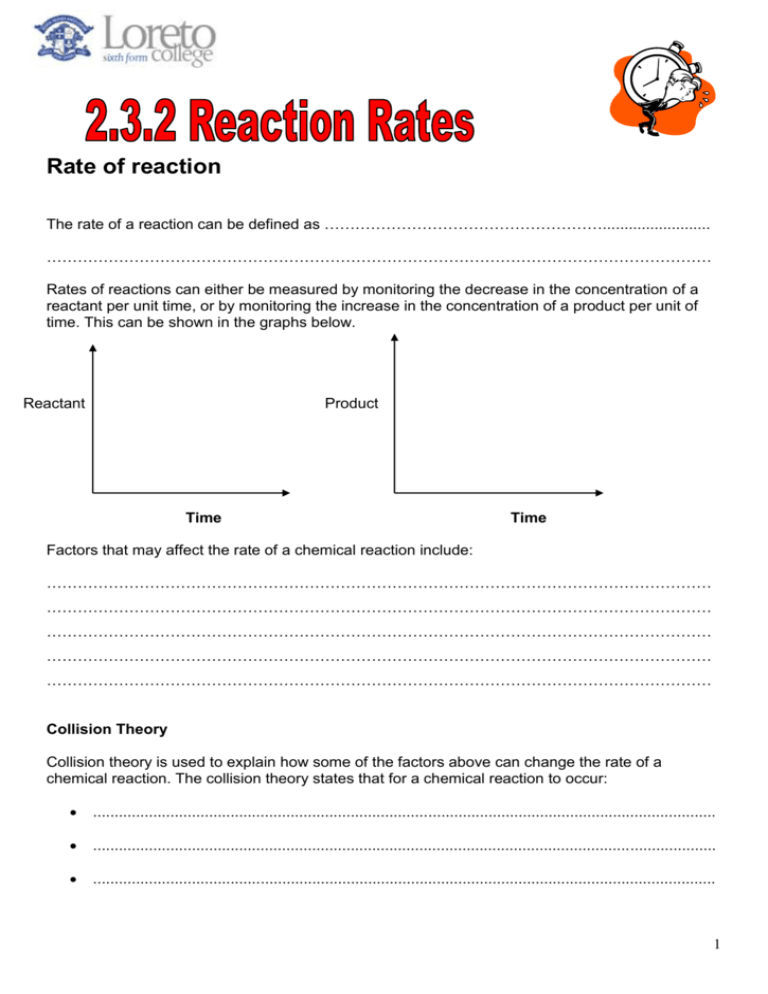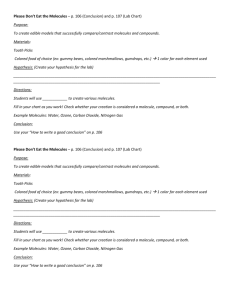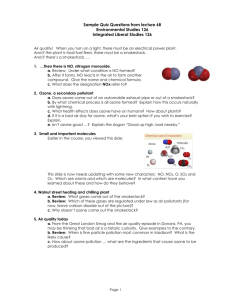Rate of reaction
advertisement

–– Rate of reaction The rate of a reaction can be defined as ………………………………………………......................... ………………………………………………………………………………………………………………… Rates of reactions can either be measured by monitoring the decrease in the concentration of a reactant per unit time, or by monitoring the increase in the concentration of a product per unit of time. This can be shown in the graphs below. Reactant Product Time Time Factors that may affect the rate of a chemical reaction include: ………………………………………………………………………………………………………………… ………………………………………………………………………………………………………………… ………………………………………………………………………………………………………………… ………………………………………………………………………………………………………………… ………………………………………………………………………………………………………………… Collision Theory Collision theory is used to explain how some of the factors above can change the rate of a chemical reaction. The collision theory states that for a chemical reaction to occur: ................................................................................................................................................. ................................................................................................................................................. ................................................................................................................................................. 1 The effect of concentration on reaction rate If the concentration of the reactants in a solution or in a gas increases, the rate of reaction increases. At a higher concentration there are more reactant particles in a given volume. This means that there are more collisions and it more likely that one of these collisions will lead to a successful reaction. Here we have a few molecules. There are few collisions. per second The rate is low. Here we have many molecules. There are more collisions per second The rate of reaction is high. The effect of pressure on reaction rate When the pressure of a gas is increased, the molecules are pushed closer together. The number of molecules remains the same but the space occupied is less. This means that there is a greater likelihood of the molecules colliding, therefore more chance of successful collisions and that this will result in an increase in the reaction rate. Here we have a number of molecules in a gas phase reaction. The molecules have space to move around and so there is little chance of a collision. Increasing the pressure decreases the volume. The molecules have less space to move in and there will be more collisions per unit time. 2 The effect of temperature on reaction rate As the temperature of the reaction mixture is increased, the rate of reaction is also increased. At higher temperature: the molecules move faster and have more energy there are more collisions therefore more chance of a successful collision, so rate increases also a greater number of molecules have an energy which is greater than the activation energy. Student Activity 1 Reaction of a group II carbonate with hydrochloric acid a) Watch your teacher demonstrate the reaction of a group II metal carbonate with hydrochloric acid, plotting the production of carbon dioxide produced against time. i. Calculate the percentage error in the mass of metal carbonate used in the experiment (the error on the balance is ± 0.005g). ………………………………………………………………………………………………………… ………………………………………………………………………………………………………… ………………………………………………………………………………………………………… ii. How could the magnitude of this error be reduced? ………………………………………………………………………………………………………… ………………………………………………………………………………………………………… ………………………………………………………………………………………………………… iii. Calculate the percentage error in the volume of carbon dioxide collected in the experiment (error on the measuring cylinder ± 1cm3). ………………………………………………………………………………………………………… ………………………………………………………………………………………………………… ………………………………………………………………………………………………………… iv. Suggest a procedural error that could have a significant effect on the volume of carbon dioxide collected. ………………………………………………………………………………………………………… ………………………………………………………………………………………………………… ………………………………………………………………………………………………………… ………………………………………………………………………………………………………… 3 The table below lists a number of different experiments involving the reaction of a group II metal carbonate with excess hydrochloric acid. Experiment A B C D E F Group II metal carbonate mass (g) particle size 1 1 1 1 1 0.5 small small small large small small concentration (moldm-3) 1 1 2 1 1 1 HCl volume (cm3) 100 100 100 100 200 100 Temperature (°C) 20 40 20 20 20 20 1. Write an equation for the reaction, including state symbols, using M to represent the group II metal. ………………………………………………………………………………………………………… 2. Experiment A produces 240 cm3 of CO2. Calculate the number of moles of CO2 produced. ………………………………………………………………………………………………………… ………………………………………………………………………………………………………… 3. Calculate the number of moles of metal carbonate used, and hence determine the formula of the group II metal carbonate. ………………………………………………………………………………………………………… ………………………………………………………………………………………………………… ………………………………………………………………………………………………………… ………………………………………………………………………………………………………… ………………………………………………………………………………………………………… ………………………………………………………………………………………………………… ………………………………………………………………………………………………………… ………………………………………………………………………………………………………… 4 4. On each of the graphs below sketch a curve to show the relative rates of reaction for experiments B – F compared to experiment A. Experiment B Experiment C Experiment D Experiment E Experiment F 5 Activation energy Definition ………………………………………………………………………………………………………… ………………………………………………………………………………………………………… ………………………………………………………………………………………………………… Reactions with a large activation energy are difficult to perform. The thermal decomposition of calcium carbonate requires heating a marble chip with two Bunsen burners. Conversely, the rate of reaction may be so fast that the reaction is explosive. Explosions are very fast reactions in which a lot of gaseous product is released very quickly, such as when burning hydrogen, or explosions from TNT or dynamite. Fine powders can also cause explosions, for example coal dust or flour, and this can pose a significant risk in industries that handle flammable dusts, such as flour mills, sugar refineries and wood processing plants. Student Activity 2 Use collision theory to explain why combustible dusts such as flour pose such an explosion hazard in industry. ............................................................................................................................................................................. ............................................................................................................................................................................. ............................................................................................................................................................................. ............................................................................................................................................................................. ............................................................................................................................................................................. ............................................................................................................................................................................. ............................................................................................................................................................................. ............................................................................................................................................................................. ............................................................................................................................................................................. ............................................................................................................................................................................. ............................................................................................................................................................................. ............................................................................................................................................................................. 6 The Maxwell - Boltzmann Distribution The Maxwell-Boltzmann Distribution is a plot of the number of particles having each particular energy. IMPORTANT: The area under the curve is a measure of the total number of particles present. The graph should always show activation energy for the reaction. The shaded area on the graph represents the number of molecules with sufficient energy to react, i.e. they have energy greater than or equal to the activation energy. The majority of the particles don't have enough energy to react when they collide. To enable them to react we either have to change the shape of the curve, or move the activation energy further to the left. 7 The effect of temperature on the Maxwell Boltzmann Distribution: T1 and T2 In a reaction mixture, there is a wide distribution in the energies of the molecules. Some molecules have high energy, many (about 60%) have an average energy and some have very low energy. Number of molecules Energy Notice that most molecules in the mixture have an average energy. The area under the curve represents the total number of molecules in the mixture The shaded area under the curve represents the number of molecules with sufficient energy to react if they collide. The effect of temperature on the Boltzmann Distribution At higher temperatures, the kinetic energy of the molecules is increased. The Boltzmann distribution flattens and shifts to the right. The shaded area under the curve is greater. A higher proportion of molecules have sufficient energy to undergo a successful reaction when they collide. Therefore the rate of reaction increases. Note that there are the same number of molecules in the system so the area under the curve does not change. 8 Catalysts Definition ...................................................................................................................................................... The role of a catalyst ...................................................................................................................................................... ...................................................................................................................................................... The effect of a catalyst on the Boltzmann Distribution Number of molecules Energy Since the catalyst lowers the activation energy, the shaded area under the curve has increased. This indicates that more molecules in the mixture will possess sufficient energy to react providing they collide. Student Activity 3 – True/False 1. 2. 3. 4. The area under the curve is equal to the total number of molecules present. T/F The plot starts at zero showing that some molecules have zero energy. T/F Increasing the temperature increases the area under the curve. T/F When a catalyst is added to a reaction, the area under the curve to the right of the activation energy line increases. This is because the activation energy line has shifted to the left. T/F 5. Decreasing the temperature of a reaction will result in the Maxwell-Boltzmann distribution shifting to the left and the maxima increasing. T/F 9 Catalysis in industry Catalysts have great economic importance. They are used in many industrial processes. Petroleum Processing Cracking – The breaking up of long chained hydrocarbons into shorter chained alkanes and alkenes, which are efficient burning fuels. Example Catalyst: C10 H22 → ………………… Margarine Manufacture Hydrogenation is a process where vegetable oil is converted into margarine. Margarines can be made with different “spreadabilities” depending on the degree of hydrogenation. Catalyst: Example: Vegetable oil + H2 → margarine ……………… Ammonia Manufacture The ………………………………………… is used to make ammonia. Here …………………… and …………………. are reacted together to form ammonia with a catalyst of ………………………... Equation: 10 Energy profile diagrams The energy profile diagram shows the progress of a reaction from reactants to products. Note how energy changes during the reaction. A catalyst lowers the activation energy of the reaction and hence the catalysed path is of a lower energy than the original path but notice that the catalyst does not alter the value of H. Although catalysts speed up a reaction they are not consumed by the overall reaction. Catalysts affect the conditions needed, often requiring lower temperatures and reducing energy demand and CO2 emissions from burning of fossil fuels. This leads to reduced waste and more economic reactions (including better atom economy). Exothermic Reaction Energy Endothermic Reaction Energy Reaction Pathway Reaction Pathway 11 Types of Catalyst There are two types of catalyst: homogeneous and heterogeneous. Homogeneous Catalysis ........................................................................................................................................................ ........................................................................................................................................................ Examples of Homogeneous Catalysis Esterification H2SO4 C2H5OH(l) + CH3COOH(l) CH3COOC2H5 (l) + H2O(l) The sulphuric acid catalyst, ethanol and ethanoic acid are all in the same phase (all are liquids). Depletion of Ozone Cl 2O3(g) 3O2(g) The chlorine radical (Cl●) and ozone are in the same (gas) phase. Cl● reacts with ozone to make an intermediate ClO● which then is reformed afterwards (see page 14). How a homogeneous catalyst functions A homogeneous catalyst forms an intermediate with the reactants. The intermediate then breaks down to give the product and regenerates the catalyst. The Ozone Layer The ozone layer is a layer in Earth's atmosphere which contains relatively high concentrations of ozone (O3). This layer absorbs 97-99% of the sun's high frequency ultraviolet light, which is potentially damaging to life on earth. Over 90% of ozone in earth's atmosphere is present here. It is mainly located in the lower portion of the stratosphere from approximately 15 km to 35 km (stratosphere) above Earth's surface, though the thickness varies seasonally and geographically. Ozone in the upper atmosphere (stratosphere) protects living organisms by preventing harmful radiaton from reaching the Earth’s surface. Ozone in the lower atmosphere (trophosphere) is an air pollutant and has harmful effects on the respiratory systems of animals. 12 The oxygen-ozone cycle Ozone is created naturally in the stratosphere by the combining of atomic oxygen (O) with molecular oxygen (O2). This process is activated by sunlight. There are two steps to the formation of ozone. Firstly, oxygen molecules absorb ultraviolet (UV) radiation and break down into oxygen atoms. These atoms then react with O 2 molecules to form ozone. This process is exothermic: O2 O2 + O 2O O3 This is a reversible reaction as O3 molecules absorb UV radiation and are converted back into O 2 molecules and O atoms. These O atoms immediately react with other O2 molecules to produce O3 again. In this way the chemical energy released when O and O2 combine is converted into heat and the overall effect is to convert penetrating UV radiation into heat without any net loss of ozone. The ozone layer naturally shields Earth's life from the harmful effects of the Sun's ultraviolet radiation. A severe decrease in the concentration of ozone in the ozone layer could lead to the following harmful effects: an increase in the incidence of skin cancer (ultraviolet radiation can destroy acids in DNA); a large increase in cataracts and sunburn; suppression of immune systems in organisms; adverse impact on crops and animals; reduction in the growth of phytoplankton found in the Earth's oceans; cooling of the Earth's stratosphere and possibly some surface climatic effect. Student Activity 4 Complete the following statements The production of ozone occurs in the ………………. state. When oxygen absorbs UV it makes the ……………………. vibrate and then break. UV radiation is …………………… by the ozone molecules when light passes through the atmosphere. In this reversible reaction O2 molecules and O are in ………………….. with O3. An increase in UV radiation at the surface of the planet is likely to cause an increase in ……………. cancer. 13 Depletion of Ozone – an example of homogeneous catalysis Ozone is destroyed naturally by the absorption of ultraviolet radiation Cl● 2O3 (g) 3O2 (g) The chlorine radical (Cl●) is acting as a homogeneous catalyst as it is in the same phase (gas) as the ozone molecule. The Cl● works by forming an intermediate with the reactants which then breaks down to give the products and regenerates the catalyst. Ozone is constantly being formed and broken down in the stratosphere by the action of ultra violet radiation on chlorofluorocarbons (CFCs). This causes the formation of chlorine radicals (initiation step): The gaseous free radicals react with ozone in a chain reaction (propagation): Cl● (g) + O3 (g) → ……… (g) + O2 (g) ……… (g) + O3 (g) → ……… (g) + 2O2 (g) An overall equation for the above reaction. CFCs may have a long residence time in the atmosphere, even after they are no longer used in certain applications. Nitrogen oxides as catalysts in ozone destruction Radicals from NOx gas from thunderstorms and aircraft may also catalyse the breakdown of ozone. Equations showing the chain reaction (propagation steps) when an NO ● radical reacts with an ozone molecule to produce oxygen. An overall equation for the reaction: 14 Student Activity 5: Questions 1. Draw a displayed formula for ozone?........................ 2. What does the term radical mean? ........................................................................................................................................................ 3. Where is the ozone layer found? ........................................................................................................................................................ 4. Give equations for the two reactions occurring in the formation of ozone. ........................................................................................................................................................ ........................................................................................................................................................ 5. Draw 2 displayed formulae of chlorofluorocarbons with the molecular formula C2Cl3F3 ........................................................................................................................................................ ........................................................................................................................................................ 6. Use the data below to explain which is the most likely halogen radical to be produced from one of these molecules. Bond C-C (single) C-F C-Cl Bond Enthalpy / kJ mol-1 +347 +467 +326 ........................................................................................................................................................ ........................................................................................................................................................ 7. Write an overall equation for the depletion of the ozone layer by the halogen radical. What conditions are required for this to take place? ........................................................................................................................................................ 8. What type of bond breaking occurs when a halogen radical is formed? ........................................................................................................................................................ 15 Heterogeneous Catalysis ........................................................................................................................................................ ........................................................................................................................................................ Examples of Heterogeneous Catalysis Haber process Fe(s) N2(g) + 3H2(g) 2NH3(g) The iron catalyst is in a different phase (solid) to nitrogen and hydrogen. Catalytic converter Rh/Pd/Pt(s) 2NO(g) + 2CO(g) N2(g) + CO2(g) Controlling Air Pollution Catalytic Converters convert harmful exhaust gases in vehicles into less harmful gases. They are heterogeneous catalysts as they are in a different phase to the reactants. 2NO(g) + 2CO(g) → N2(g) + 2CO2(g) Catalyst: Rh/Pd/Pt (s) A car engine produces pollutant gases and in order to combat this cars are fitted with catalytic converters. Gas CO Origin Incomplete combustion of hydrocarbons in petrol. Effect Poisonous gas combining with haemoglobin in blood and preventing the binding of oxygen. NO Nitrogen from the air reacts with the oxygen in the air at high temperatures in a car engine: N2 + O2 → 2NO Formation of low-level ozone. Much is converted into HNO3 which contributes to acid rain. Produces photochemical smog: 2NO + O2 → 2NO2 (a brown gas) CxHy Unburnt hydrocarbons in the petrol. Some are toxic and act as carcinogens (can cause cancer). Also low-level ozone is a pollutant caused by reaction of unburnt hydrocarbons and NO2 using energy from sunlight. Low-level ozone is a serious pollutant, causing breathing difficulties and increasing susceptibility to infections.The solid Rh/Pd/Pt catalyst is supported on a ceramic honeycomb, which gives a large surface area, greatly improving the effectiveness of the solid catalyst. Each of the poisonous gases produces is converted into a non harmful material. A catalytic converter helps to promote the following reactions: 2NO(g) 2CO 2NO 2C6H6 C12H26 + 2CO(g) + O2 + 15O2 + 18½O2 → N2(g) → 2CO2 → N2 → 12CO2 → 12CO2 + CO2(g) + O2 + 6H2O + 13H2O 16 How this heterogeneous catalyst functions A heterogeneous catalyst provides a surface for the reaction to take place on. The catalytic convertor works in three basic stages: 1. Adsorption of the molecules at the catalytic surface 2. Chemical reaction (bonds are weakened). 3. Desorption of the product molecules away from the catalyst. Bonding to the catalyst surface must be weak enough for adsorption and desorption to take place but strong enough to weaken bonds and allow the reaction to take place. Student Activity 6 Match up the correct word and definition. Adsorption Carcinogens A smoky fog caused by air pollution. Red globular protein in blood which carries oxygen from the lungs to the cells in body tissues. Catalyst Ceramic Compounds which can cause cancer. Reaction that occurs in the presence of a limited amount of oxygen. Usually leads to the production of CO. Desorption A process in which atoms, molecules or ions are held on the surface of a solid. Haemoglobin Removal of an adsorbed molecule, atom or ion from an adsorbent. Incomplete Combustion Alters the rate of a chemical reaction without permanently changing chemically. Smog Materials such as pottery, glasses, cement, concrete and graphite. Nonmetallic, inorganic materials heated to a high temperature at some point during their manufacture. 17 Past Paper Jun 2010 NB Exothermic reaction (given in the previous part of the exam question) [7] 18







